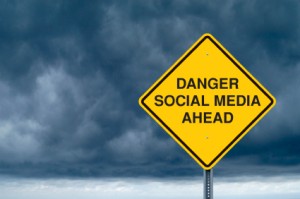My Klout Is Growing
 I’m happy to report that my Klout has grown 430% since I first began monitoring it in October 2011. Clearly, I’m an influential guy.
I’m happy to report that my Klout has grown 430% since I first began monitoring it in October 2011. Clearly, I’m an influential guy.
Klout is an application that purports to measure how influential I am in the world of social media. It’s based on the two-step theory of mass communication. In step one, a mass marketing campaign influences a relatively small number of people. Let’s call them the target audience. In step two, members of the target audience reach out to their social circles and influence them.
Let’s say you’re trying to recruit volunteers to work for a political party. You launch a massive advertising campaign. A lot of people see the campaign but only a few are moved to action. These people, however, through their web of friendships and acquaintances, can move a much larger number of people.
Unfortunately, you pay for the total number of people who see the campaign, not the (much smaller) number of influential people. Wouldn’t it be nice if you only paid for reaching influential people? The question is: how do you find them?
That’s where Klout comes in. Klout measures my impact in social media. It tracks what I do on Twitter, Facebook, Google +, LinkedIn, and a few others. It notes how many followers and friends I have. It also tracks my impact. It’s good to have a large number of followers and friends. It’s even better when those followers “like” my posts, forward my articles, and re-tweet my tweets.
The result of all this counting and measuring is a Klout score that ranges between zero and 100. The higher the score, the more influential you are. The higher the score, the more valuable you are to advertisers.
Remember that we’re talking about social media here – not influence in the real world. Thus, it’s not too surprising that Justin Bieber’s Klout score is 100 whereas Barack Obama’s is 88. President Obama can move people. Bieber can move merchandise.
Klout doesn’t “sell” high scoring individuals to advertisers. It’s a bit more subtle. It uses “perks” to attract people to sign up and to link them marketers.
When I first registered with Klout, my score was 10. That’s pathetic and no advertiser wanted to connect with me. As I’ve built my social media empire, my Klout score has risen to a much more respectable 53.
Now advertisers are interested in me. They want to give me “perks” that will keep their products at the top of my mind. In fact, I just cashed in a perk and received a free subscription to Red Bulletin, a splashy magazine published by the energy drink, Red Bull.
The makers of Red Bull seem to believe that, if I read Red Bulletin, I will exercise my massive influence and cause my circle of social media friends to drink more Red Bull. I’m not sure that’s going to happen. By and large, the people I influence are just not in the Red Bull demographic. Perhaps the makers of Geritol would be better served by “perking” me.
I’m going to keep track of my Klout score largely because I use it in my marketing classes. I’ll report on it every now and then. I hope you’ll help me keep my Klout score high by “liking” my posts and re-tweeting my tweets. Of course, you could also buy some Red Bull.
Social Media, Bosom Buddies, and Christmas Card Friends

Bosom Buddies
I try to keep up with the latest trends in social media. I’m especially interested in how my clients might use it to improve communications internally with employees or externally with customers and partners.
Over the years, I’ve seen the persistent criticism that the “social” in social media is Orwellian – it does the opposite of what it claims to do. Just as Big Brother promised freedom but offered enslavement, social media promise to create closely knit communities but actually insert an intermediate layer where none is needed. Rather than making us more social, it separates us further.
That’s the complaint… but is it true? As I use social media, I find that I need to segment the market to get real benefits. For some segments, social media doesn’t help me much at all. For other segments, it keeps me in better contact with people than ever before.
The two big segments for me are: 1) Bosom Buddies, and; 2) Christmas Card Friends. Bosom Buddies have two defining characteristics: 1) they’re close friends or colleagues that I want to keep up with, and; 2) I see them or talk to them or e-mail them often. I know what’s going on in their lives.
With Bosom Buddies, social media add no value whatsoever. I’ve never, ever learned a juicy new tidbit about a Bosom Buddy from a social media source. I’ve always heard it first from a more traditional source – a dinner party, a phone call, or just plain old-fashioned gossip. Social media add an unnecessary layer of communication that doesn’t get me any closer to my Bosom Buddies.
With Bosom Buddies, the grapevine is a powerful and prolific source of information. In fact, I sometimes hear that active participation in social media is an effective substitute for going to the office. With Bosom Buddies, the reverse is true: going to the office is an effective substitute for social media.
With Christmas Card Friends, things are different. I like my Christmas Card Friends just as much as my Bosom Buddies but I don’t see them nearly as often. They may live in another town. Or maybe they travel in slightly different social circles. Or maybe they have young children and don’t get around much any more.
Whatever the case, I don’t get to see them as often as I’d like. Nor do I hear from them (or they from me) frequently, even though I would like to. In some cases, I only hear from them though the traditional social medium called Christmas Cards.
With Christmas Card Friends, social media can add significant value. I can fairly easily keep up with people I enjoy but don’t interact with regularly. Social media are a source of new news. I regularly learn new things about Christmas Card Friends through social media. I enjoy that and I think it enriches our relationship.
As you think about social media – whether personal or professional – think about your market segments. You may find that targeting Christmas Card Friends rather than Bosom Buddies will lead you to richer, more enjoyable interactions.
Teens Dump Social While Companies Rush In
 Last month a Piper Jaffray survey asked 5,000 teenagers in the United States to identify their “most important social media sites.” Facebook was still the most important but it had declined steeply compared to Piper Jaffray surveys taken six months and 12 months earlier. Indeed, Facebook was barely ahead of YouTube.
Last month a Piper Jaffray survey asked 5,000 teenagers in the United States to identify their “most important social media sites.” Facebook was still the most important but it had declined steeply compared to Piper Jaffray surveys taken six months and 12 months earlier. Indeed, Facebook was barely ahead of YouTube.
Why did it happen? Well, teenagers are fickle. Additionally more and more old folks are invading the Facebook space, which may be driving the younger set away. Advertising may be partially to blame as well. As I learned with my brief foray into Facebook advertising, a lot of users react violently to the presence of ads in their news feeds.
Overall, however, I think the most cogent analysis comes from Cliff Watson’s blog on Medium. Watson essentially says that teens have better things to do and faster, simpler ways of doing it.
As the teens decamp, however, companies are rushing into social media. In March, McKinsey published its sixth annual survey on the business use of social media. The survey, conducted in 2012, received responses from 3,542 executives representing companies around the world. Some 83 percent of respondents say their companies are using at least one social medium (up from 72 percent in 2011) and 90 percent of those report measureable benefits.
Companies are using social media both internally and externally. The top benefits for internal use (in order) are: 1) faster access to knowledge; 2) reduced communication costs; 3) reduced travel costs. For external use, the top three benefits are: 1) increased marketing effectiveness; 2) increased customer satisfaction; 3) reduced marketing costs.
This also seemed to be the year that companies jumped on the mobile bandwagon. Sixty-five percent of the respondents said their companies were using at least one social medium on mobile technologies. As in previous surveys, the three primary uses for mobile were: 1) marketing; 2) sales; 3) IT.
While mobile is growing rapidly, the use of big data is more of a challenge. Indeed, executives don’t quite seem to know what to make of big data. According to McKinsey, “ … between 42 and 54 percent of respondents say either that they don’t know how their companies use the data or that these practices aren’t yet applicable to their companies.”
And the downside? A majority of respondents say that the major risk is that confidential information may be leaked. But 60 percent agree that the benefits outweigh the risks.
Teens seem to be moving away from “traditional” social technologies while companies are moving in. Coincidence? I think not. It’s like two animals competing for the same ecological niche. As one moves in, the other moves out. That’s not necessarily a bad thing. Companies can still get a lot of benefits from social media. They just won’t get the teens.
I’m a Facebook Spammer. Apparently.

A spammer? Moi?
I run my little consulting business out of an expansive office in our basement. The business is going reasonably well — I have clients in both Sweden and the United States. Still, I have some slack time every now and again. I need to do some marketing to build the business.
So far, my marketing consists of this website, some social media, and some nice t-shirts. (If you want a t-shirt, send me your size). I maintain a Twitter feed, a Facebook page, and a Linked In page. I considered advertising on the Super Bowl but decided that the demographics were wrong. Then I noticed that my Facebook views had dropped dramatically. Even people who had “liked” my page weren’t seeing my posts. Facebook had apparently changed its algorithms to “suppress” views of pages that don’t advertise with the company. (For more on this, see Nick Bilton’s post in the New York Times).
So I decided to advertise on Facebook. I think I create some pretty good posts, so I simply paid Facebook to advertise them for me. I made a modest investment — $5 on some days and $10 on days when I addressed a really hot topic. The results were weird to say the least.
First the results were completely unpredictable. On the day before I bought my first ad, 29 people saw my post — though I have well over 500 friends on Facebook. With my first ad — a $5 day — 7,055 people saw my post and I got four “likes”. Here’s what happened on subsequent days:
- Day 2 1,355 views
- Day 3 894 views
- Day 4 1,599 views
- Day 5 40 views
- Day 6 7,421 views
- Day 7 982 views
- Day 8 661 views
- Day 9 169 views
- Day 10 18,360 views
I had asked Facebook to show my ads to people over 25 years of age who said that they enjoy reading. I didn’t change my criteria throughout the ten-day trial but I had no idea what to expect from day to day.
Then I started getting nastygrams (some very nasty) from other Facebook users. To advertise my work, Facebook simply takes one of my posts and inserts it into other users’ news feeds. A number of users, who don’t know me from Adam, took strenuous exception to this, posted obscene messages in my news feed, and reported me for spamming. I corresponded with one such user who asked me never to spam him again. I pointed out that I had bought an ad without the intention of spamming anybody. He considered it spam and had asked Facebook to “adjust their algorithm” to punish me as a spammer.
I wondered if Facebook would actually charge me for an ad and then downgrade my algorithm for spamming. That takes some chutzpah. Unfortunately, I haven’t been able to find out if this actually occurs. Frankly, I just don’t know whom to ask. Despite its name, Facebook is a rather faceless organization.
So, I’ve given up my Facebook ad campaign. I’m tired of the obscene responses. And, like the Super Bowl, I wasn’t reaching the right demographic. I did get more views and more “likes” but, after reading the profiles of those who “liked” me, I just don’t think any of them are going to buy my business-to-business consulting services. So, I’m looking for other ways to advertise my business. In the meantime, I still have some nice t-shirts.
Social Media for Business Leaders
 As a marketing guy, I understand (sort of) the marketing aspects of social media. If you can start a conversation — and keep it interesting — you can engage your market in ways that are impossible with “interruption marketing”. You can exchange ideas, gather suggestions, support charities, and engage in positive social activities. Along the way, you can mention your products. You offer something of interest (or utility) and the products tag along for the ride.
As a marketing guy, I understand (sort of) the marketing aspects of social media. If you can start a conversation — and keep it interesting — you can engage your market in ways that are impossible with “interruption marketing”. You can exchange ideas, gather suggestions, support charities, and engage in positive social activities. Along the way, you can mention your products. You offer something of interest (or utility) and the products tag along for the ride.
But social media is not just about marketing. Executives should be able to use social media to enhance both internal and external communication. Yet, I haven’t found many examples in the literature. Fortunately, McKinsey just published an interesting case study based on GE’s experience. The authors, who are GE leaders themselves, point out that GE is not a “digital native” and its experiences may, therefore, be relevant to a wide range of organizations. They then outline six social media skills that all leaders need to learn. The first three are personal; the last three are strategic or organizational.
Producer — creating compelling content. Digital video tools are now widely available and easy to use. Even busy senior executives can weave them into their communications. As compared to traditional top-down communications, the emphasis shifts from high production quality to authenticity. The goal is to invite participation and collaboration. Speaking plainly and telling stories in an authentic voice invites participation much better than a highly produced video.
Distributor — leveraging dissemination dynamics. Instead of sending a message and expecting it be consumed, you now send a message and expect it to be mashed up. A successful social message will be picked up by people at all levels of the organization, commented on, “recontextualized”, and forwarded along. You want this to happen which means giving up a significant amount of control — not always an easy concept for executives. You also want to build up a followership within the organization long before you need it.
Recipient — managing communication overflow. We’re already drowning in information. Why take on social media? Because it’s more credible than top-down media. By learning to use filters effectively, you can also use social media to manage the flow of information to and from your desk. You should practice when and how to respond to postings and tweets. You don’t need to respond frequently but you do need to respond thoughtfully.
Advisor and orchestrator — driving strategic social media utilization. Fundamentally, executives need to promote the use of social media and guide it to maturity. Your company may be enthusiastic but inexperienced. Or you may have leaders who wish to avoid it altogether. A good leader can harness the enthusiasm of “digital natives” and even use them as “reverse mentors” to build capabilities within the organization.
Architect — creating an enabling organizational infrastructure. On the one hand, you want to encourage collaboration and free exchange. On the other hand, you need some rules. It helps if you have well-established values of integrity, collaboration, and transparency. If your company hasn’t established these values, it’s time to get started. Social media will arise in your organization whether you’re ready or not.
Analyst — staying ahead of the curve. As your organization masters social media, something new will emerge. Perhaps, it’s the Internet of Things. As I’ve noted before, this could help us reduce health care costs. It could also have huge implications for your organization — both good and bad. Better stay awake.
And what do you get if your company’s leaders master these skills? The authors say it best: “We are convinced that organizations that … master … organizational media literacy will have a brighter future. They will be more creative, innovative, and agile. They will attract and retain better talent, as well as tap deeper into the capabilities and ideas of their employees and stakeholders.”